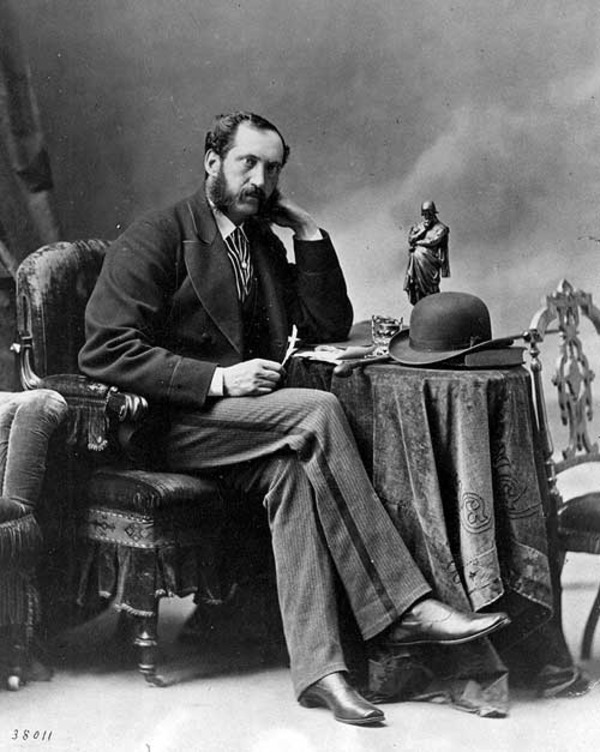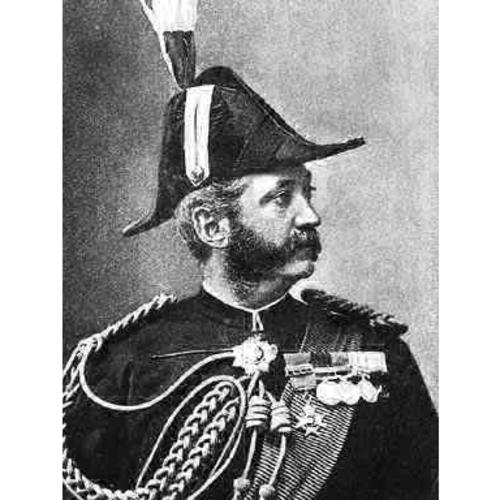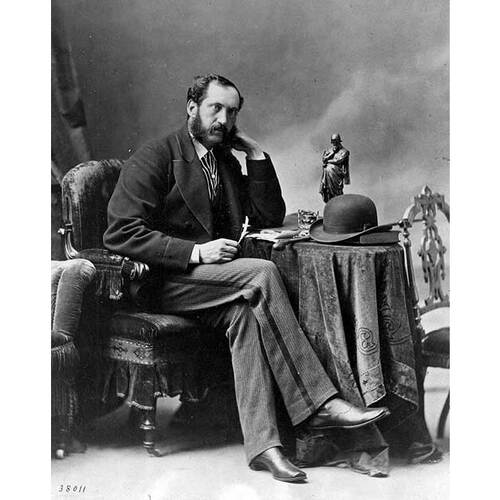As part of the funding agreement between the Dictionary of Canadian Biography and the Canadian Museum of History, we invite readers to take part in a short survey.

Source: Link
BUTLER, Sir WILLIAM FRANCIS, army officer and author; b. 31 Oct. 1838 at Suirville (near Bansha, Republic of Ireland), seventh child of Richard Butler and Ellen —; m. 11 June 1877 Elizabeth Southerden Thompson in London, England, and they had three daughters and two sons; d. 7 June 1910 at Bansha Castle (Republic of Ireland).
William Francis Butler was born into an impoverished family of Tipperary gentry with a tradition of service to the British crown. As a child, he observed the ravages of the Great Famine and seems to have been left with a permanent sympathy for the underdog. Although his education was interrupted because his father spent all his money aiding famine victims, Butler developed a passion for history and biography that occupied his leisure until his death.
Butler joined the 69th Foot as an ensign on 17 Sept. 1858 and saw service in various parts of the British empire. The regiment was sent to Burma in 1860 and then to Madras, India. In the east Butler developed the habit of combating the boredom of peace-time garrison duty through travel and writing. He returned to England as a newly promoted lieutenant in 1863. Three years later the 69th was stationed in the Channel Islands, where he made friends with Victor Hugo. The Fenian raids brought the regiment to Canada in 1867.
Here the real foundations of Butler’s military and literary careers were established. The summer of 1869 was the low point in his fortunes. In line for promotion, he could not afford to purchase a vacant captaincy and for the only time he seriously considered leaving the army. He decided instead to return to England and make a final effort to persuade the authorities of his merits. He was unsuccessful, but just then word arrived that Colonel Garnet Joseph Wolseley* was organizing an expedition to the Red River settlement (Man.) in the aftermath of the resistance led by Louis Riel*. Butler had met Wolseley and he cabled a request to join his staff. Without waiting for a reply he took the next boat for North America. He caught up with Wolseley before the expedition left Toronto but too late to obtain a staff position. Undeterred, he suggested that by going through the United States he could investigate reports of Fenians gathering to attack the force and could also visit Red River. Wolseley, the most capable British soldier of the period, immediately recognized the potential of the plan. By the end of June 1870, Butler was on his way to St Paul, Minn. Finding no evidence of warlike activities he proceeded to Red River with the intention of gathering intelligence and then going eastward to meet the expedition.
To pass through a community as small as Red River without discovery was impossible, and Riel’s followers found Butler and arranged a meeting. Riel assured him of his peaceful intentions and then allowed him to go. Butler travelled to Fort Frances (Ont.) and helped guide the expedition the remainder of the way. As soon as Canadian authority had been firmly established, preparations began for the withdrawal of the British troops. Butler, who had fallen in love with the northwest, stayed until October 1870 and was taking a reluctant leave when Lieutenant Governor Adams George Archibald* asked him to travel through the newly acquired western territory and report on conditions. Butler set out on 24 October for Edmonton.
Butler’s winter journey not only produced an influential report for the Canadian government but became the basis for his best book, The great lone land. Taking the fur-trade route by way of forts Ellice (Man.), Carlton (Sask.), Pitt (Sask.), and Victoria (Victoria Settlement, Alta), he reached Edmonton on 26 November. After a few days’ rest he left for Rocky Mountain House, where he arrived on 5 December. Here he tried unsuccessfully to find a guide who would take him south into Blackfoot country. When this effort failed he returned to Edmonton and prepared for the journey back to Red River, by dog team in the dead of winter. By 20 Feb. 1871 he was at Upper Fort Garry (Winnipeg) and two weeks later his report was in Archibald’s hands.
The report focused on the state of the native population and made recommendations as to how the Canadian government should go about establishing its authority with the least possible disruption. Butler’s proposals for travelling magistrates and a specially recruited police force were eventually followed, but the general attitude of the report was more important than any of its details. The revulsion it expressed at the “war of extermination” being waged by the American government against the Plains peoples and the assumption that Canadians could do much better caught perfectly the best intentions behind Canadian westward expansion. Not surprisingly the report and its author were enthusiastically received by Prime Minister Sir John A. Macdonald* and his cabinet when Butler reached Ottawa in April.
After returning to England and completing The great lone land, Butler learned in the spring of 1872 that oil had been discovered on some land he had invested in near Petrolia, Ont. Profit from sale of the land enabled him to return to Canada. Over the winter of 1872–73 he travelled his earlier route as far as Fort Carlton and then went north to Lake Athabasca and the Peace River. When the ice broke up in the spring, he made his way west through the Peace River canyon into central British Columbia and down the Cariboo Road to the coast. By the summer of 1873 he was back in Ottawa with the manuscript of a new book, The wild north land, nearly completed.
Butler was apparently thinking seriously about settling in Canada when word arrived that Wolseley would command an expedition against the Ashanti in west Africa. A telegram to Wolseley arrived in time to get Butler a position, and he performed with his usual combination of energy and imagination. The campaign solidified his place among Wolseley’s protégés, brought him a promotion to major in 1875, and assured that he would serve in most of the important British colonial wars of the late 19th century. In an interval of home service Butler met and married Elizabeth Southerden Thompson, a painter whose battle scenes were enormously popular in Victorian England. Advanced to colonel in 1882, he made his last trip to Canada in the summer of 1883 when he visited briefly to evaluate a tract of land in what is now northern Saskatchewan for a syndicate of London investors.
Butler played a role in two great crises of the late Victorian era. In 1884 he persuaded Wolseley that a brigade of boats manned by Canadian voyageurs was the best hope of getting a relief column up the Nile to rescue the besieged Major-General Charles George Gordon at Khartoum [see Frederick Charles Denison*]. On his return to England from Egypt in 1886, Butler’s promotion to brigadier-general was confirmed and he was made a kcb. He became major-general in 1892. In 1898 he was appointed commander of the British forces in South Africa. The situation there was tense, with the governor of the Cape Colony, Sir Alfred Milner, being determined to assert British supremacy over the independent Boer republics of the Transvaal and the Orange Free State. He wanted a military commander who would prepare for an offensive war under the guise of planning for defence. No British officer of the period could have been less suited to this situation than Butler. An Irish Catholic and an advocate of home rule for Ireland, he thought Milner’s policy outrageous in principle and dangerous in practice and he refused all cooperation with the governor that seemed likely to provoke conflict. When it became apparent that his position would not receive the backing of the War Office, he resigned. After the dispute became public knowledge, Butler was referred to as “the radical general” and was pilloried in the press. The disasters of the early stages of the war restored him to public favour, however, and made him something of a prophet. He was promoted lieutenant-general in 1900 and retired from the army on 31 Oct. 1905.
“He who has once tasted the unworded freedom of the Western wilds must ever feel a sense of constraint within the boundaries of civilized life,” Butler wrote in 1871. His prose style seems rather florid today but it was widely praised during his lifetime. His admirers included such disparate individuals as Winston Churchill, John Ruskin, and Theodore Roosevelt. The great lone land, which had gone through 17 editions by the time of Butler’s death, is certainly the most vivid and compelling description of western Canada in the 1870s, before the victory, in his time, of “barbed wire, the grain ‘elevator,’ the machine-made boot, and the two-cent newspaper.”
[Sir William Francis Butler’s two main accounts of the Canadian northwest, The great lone land; a narrative of travel and adventure in the north-west of America and The wild north land: being the story of a winter journey, with dogs, across northern North America were published in London in 1872 and 1873 respectively, and went through numerous editions, particularly in the 19th and early 20th centuries, as can be seen from the entries in Canadiana, 1867–1900 and the National union catalog. The original editions of both works were reprinted in Edmonton in 1968.
Butler’s 1871 report to Adams George Archibald appeared as Report by Lieut. Butler, (69th Regt.) of his journey from Fort Garry to Rocky Mountain House and back, during the winter of 1870–71 ([Winnipeg, 1871 ]; an Ottawa edition was issued the same year), and as an appendix to The great lone land. His North American adventures also formed the basis of a novel, Red Cloud, the solitary Sioux; a story of the great prairie (London, 1882, and subsequent editions, including one issued in Boston in the 1880s under the title The hero of Pine Ridge . . .), and a portion of an early volume of memoirs, Far out: rovings re-told (London, 1880).
Among Butler’s publications that reflect other phases of his career are: A narrative of the historical events connected with the Sixty-Ninth Regiment (London, 1870); Akim-foo: the history of a failure (London, 1875); The campaign of the cataracts; being a personal narrative of the Great Nile Expedition of 1884–5 (London, 1887); Charles George Gordon (London and New York, 1889); The life of Sir George Pomeroy-Colley . . . (London, 1899); From Naboth’s vineyard, being impressions formed during a fourth visit to South Africa undertaken at the request of the “Tribune “ newspaper (London, 1907); and The light of the west, with some other wayside thoughts, 1865–1908 (Dublin, 1909).
Sir William Butler, an autobiography (London, 1911) was edited and issued posthumously by his youngest daughter, Eileen Butler (afterwards Preston, Viscountess Gormanston; Atkins), whose own memoirs appeared as A little kept (London and New York, 1953). His wife Elizabeth [S. Thompson] Butler published two autobiographical accounts: From sketchbook and diary (London, 1909) and An autobiography, with illustrations from sketches by the author (London, 1922).
The full-length biography by Edward Alexander McCourt, Remember Butler. the story of Sir William Butler (Toronto, 1967), is a well-balanced and accurate assessment of his career. A sketch also appears in the DNB. Leigh Maxwell, The Ashanti ring: Sir Garnet Wolseley’s campaigns, 1870–1882 (London, 1985), is useful for the military context of Butler’s career. r.c.m.]
Cite This Article
Roderick C. Macleod, “BUTLER, Sir WILLIAM FRANCIS,” in Dictionary of Canadian Biography, vol. 13, University of Toronto/Université Laval, 2003–, accessed March 28, 2025, https://www.biographi.ca/en/bio/butler_william_francis_13E.html.
The citation above shows the format for footnotes and endnotes according to the Chicago manual of style (16th edition). Information to be used in other citation formats:
| Permalink: | https://www.biographi.ca/en/bio/butler_william_francis_13E.html |
| Author of Article: | Roderick C. Macleod |
| Title of Article: | BUTLER, Sir WILLIAM FRANCIS |
| Publication Name: | Dictionary of Canadian Biography, vol. 13 |
| Publisher: | University of Toronto/Université Laval |
| Year of revision: | 1994 |
| Access Date: | March 28, 2025 |




